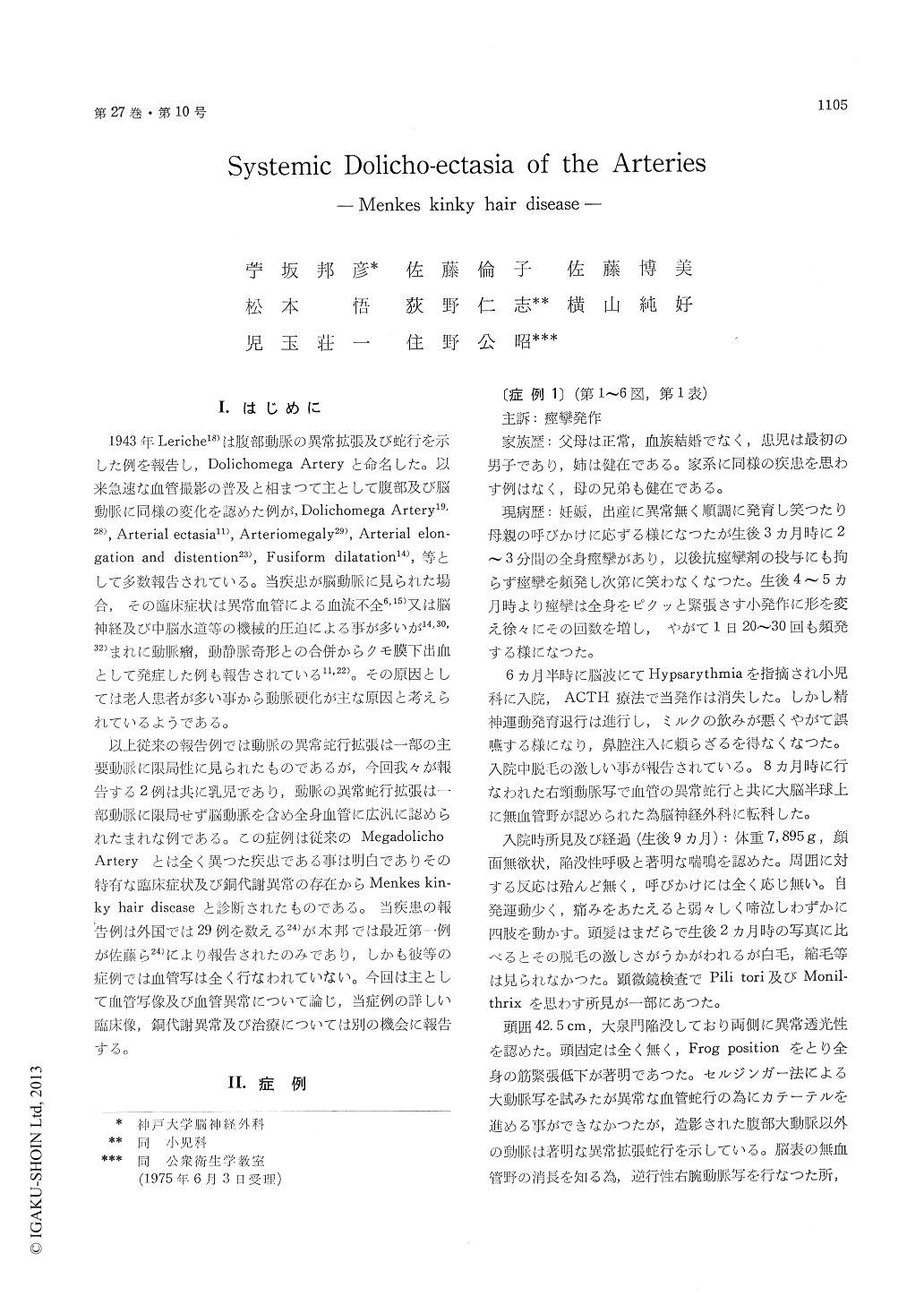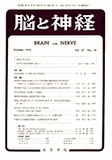Japanese
English
- 有料閲覧
- Abstract 文献概要
- 1ページ目 Look Inside
I.はじめに
1943年Leriche18)は腹部動脈の異常拡張及び蛇行を示した例を報告し,Dolichomega Arteryと命名した。以来急速な血管撮影の普及と相まつて主として腹部及び脳動脈に同様の変化を認めた例が,Dolichomega Artery19,28),Arterial ectasia11), Arteriomegaly29), Arterial elon—gation and distention23), Fusiform dilatation14),等として多数報告されている。当疾患が脳動脈に見られた場合,その臨床症状は異常血管による血流不全6,15)又は脳神経及び中脳水道等の機械的圧迫による事が多いが14,30,32),まれに動脈瘤,動静脈奇形との合併からクモ膜下出血として発症した例も報告されている11,22)。その原因としては老人患者が多い事から動脈硬化が主な原因と考えられているようである。
以上従来の報告例では動脈の異常蛇行拡張は一部の主要動脈に限局性に見られたものであるが,今回我々が報告する2例は共に乳児であり,動脈の異常蛇行拡張は一部動脈に限局せず脳動脈を含め全身血管に広汎に認められたまれな例である。この症例は従来のMegadolichoArteryとは全く異つた疾患である事は明白でありその特有な臨床症状及び銅代謝異常の存在からMenkes kin—ky hair diseaseと診断されたものである。当疾患の報告例は外国では29例を数える24)が本邦では最近第一例が佐藤ら24)により報告されたのみであり,しかも彼等の症例では血管写は全く行なわれていない。今回は主として血管写像及び血管異常について論じ,当症例の詳しい臨床像,銅代謝異常及び治療については別の機会に報告する。
Two male infants with systemic dolichoectasia ofthe arteries are reported. The first case is the firstson for normal unrelated parents, in whose familytree no other case of similar disorder is recorded.The second case's brother has already died of pro-gressive psycho-motor retardation of unknownorigin.
Both cases were considered normal until a fewmonths of age when they started to have convul-sions. These convulsions were difficult to be contr-olled by anticonvulsant. Then apparent progressivepsycho-motor regression was followed. In case 1,the type of seizures was changed into the episodesof repeated tightening up of the whole body for afew seconds. EEG revealed hypsarythmia. Suchepisodes as well as a hypsarythmia pattern in EEGwere well controlled by ACTH treatment, butpsycho-motor regression relentlessly progressed.
On admission, his general condition was poorwith sternal depression and wheezing, malnutritionand anemia of mild degree in both cases. Psycho-motor retardation was severe with little head control,little spontaneous movement and severe hypotoniaof all extremities with almost constant frog position.Tube feeding was necessary in both cases. Cerebralangiogram and abdominal aortogram were performed,which revealed extensive lengthening and tortuosityof all arteries visualized. Serum copper and cerulo-plasmin were found to be extremely low. Biopsyof the artery done in case 2 did not reveal anymarked abnormality such as fragmentation of elasticlamina, etc..
Extensive falling-off of hair was reported by hismother and segmental narrowing and twisting ofhair of mild degree was found in a few hairs undera microscope. But in case 2, no hair abnormalitywas found either macroscopically or microscopically.Diagnosis of Menkes kinky-hair syndrome is ap-parent in case 1. In case 2, hair abnormality whichis a key-diagnostic feature for this disorder is absent,but his brother's death after progressive psycho-motor regression of unknown cause, severe psycho-motor regression after normal development for thefirst 2 months, characteristic angiographic featuresand the apparent disorder of copper-metabolism, allthese features are consistent with Menkes syndrome.This case was also diagnosed as Menkes syndrome,but of an atypical type. In this case, Menkessyndrome was not suspected first, because the ab-normality of hair was not present, but characteristicangiographic features aroused the possibility ofMenkes syndrome, and copper metabolism wasstudied. As in this case, angiogram can be a usefuldiagnostic aid, for the peculiar arterial abnormalitywas found in all angiogram done on the patientswith this disorder. But similar angiographic featureswere reported also in the cases which could notbe Menkes syndrome. These angiographic featuresare characteristic but not pathognomonic of Menkessyndrome, and copper metabolism should be per-formed to establish the diagnosis.

Copyright © 1975, Igaku-Shoin Ltd. All rights reserved.


